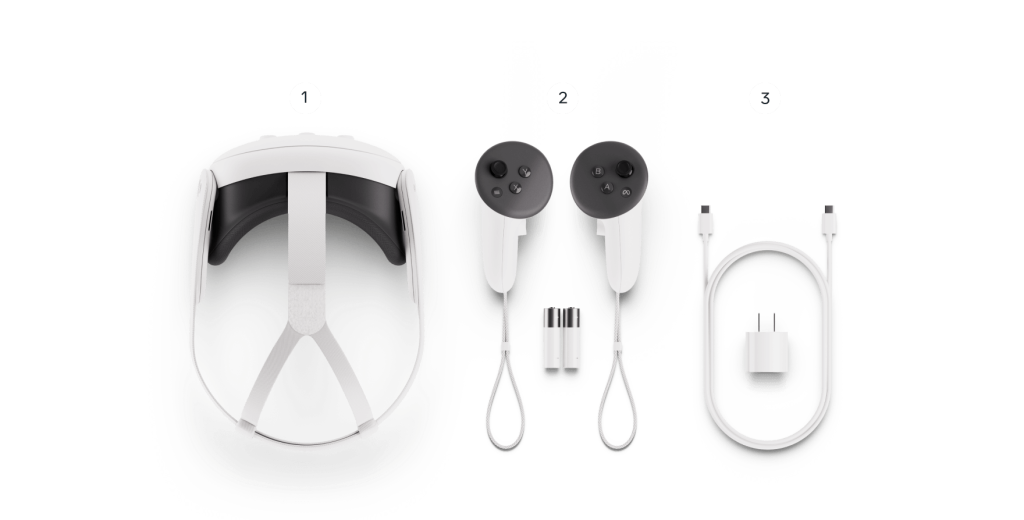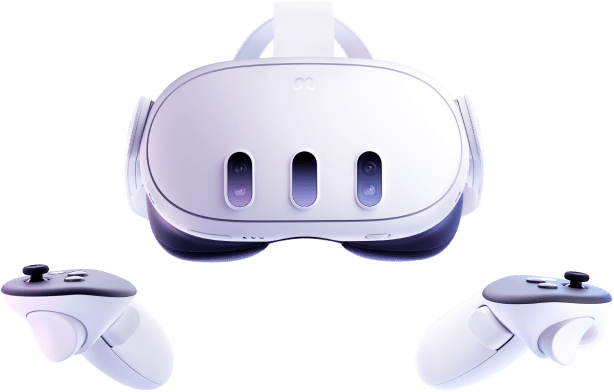The Meta Quest 3 has been officially launched and is now available for pre-order, with shipments scheduled to begin on October 10th. For those interested in getting their hands on the Quest 3 headset, we have put together a pre-order guide to help you secure your purchase.

Meta Quest 3 price and availability
In the United States, the Meta Quest 3 will have a starting price of $499 for the 128GB storage model, which represents a $100 increase compared to the Quest 2’s $299 price point. Additionally, there is an option for a larger storage capacity model with 512GB available for $649.
In the United Kingdom, the introductory price for the 128GB model is set at £479, while the larger 512GB model is priced at £619. Across the European Union, the launch prices are €549 for the 128GB variant and €699 for the 512GB option.For customers in Australia, the starting price for the base 128GB model is AU$799.

Meta Quest 3 specs
The Meta Quest 3 is available in two storage options: 128GB and 512GB. While some users might have hoped for a 256GB middle ground, the inclusion of a high-capacity option caters to those with substantial storage needs.
More significantly, the Quest 3 boasts an upgraded chipset, powered by the all-new Qualcomm Snapdragon XR2 Gen 2. This enhancement delivers double the graphics processing power compared to the Quest 2. Additionally, the Quest 3 features an upgraded RAM capacity of 8GB, surpassing the Quest 2’s 6GB. It’s worth noting, however, that the Quest 3 falls short of the 12GB of RAM offered by the Meta Quest Pro.
The Meta Quest 3 comes with a notable display upgrade. Meta has dubbed these new displays the “4K+ Infinite Display,” utilizing two LCDs and pancake optics to achieve an impressive resolution of 2,064 x 2,208 pixels per eye. This represents nearly a 30% improvement in resolution compared to the Meta Quest 2. Additional display specifications include 25 pixels per degree (PPD) in virtual reality and a pixel density of 1,218 pixels per inch (PPI).
However, when using the headset’s full-color video passthrough, there is a slight decrease in resolution. In mixed reality mode, the resolution is 18 PPD, powered by two RGB cameras, although this still represents a significant upgrade, offering “over 10x more pixels in Passthrough compared to Quest 2 and 3x more pixels compared to Quest Pro.”
Regarding the refresh rate, the Quest 3 features a native 90Hz refresh rate with an experimental 120Hz option. There is hope that future post-launch updates might enable a 144Hz refresh rate, but for now, it maxes out at 120Hz.
One area where the Quest 3 doesn’t see an upgrade is in battery life. It retains the same battery life figures as the Quest 2, which Meta states typically lasts around 2.2 hours but can extend to 2.9 hours when used for media consumption. Charging the headset from 0% to full takes approximately two hours with the included 18W charger, a similar charging time to the Quest 2.

Meta Quest 3 design
The Meta Quest 3 has undergone a comprehensive redesign, described by Meta as a transformation from the “inside out.” While the headset maintains a similar overall aesthetic to the Quest 2, its optic profile has been slimmed down by 40%, thanks in part to the use of pancake lenses. On the front of the headset, there’s a striking arrangement of two pill-shaped RGB cameras and a depth projector, which enables full-color video passthrough.
One notable addition is the Lens Distance Adjustment Wheel, offering more precise interpupillary distance (IPD) fine-tuning. The Quest 3 supports an IPD range of 53 mm to 75 mm. The inclusion of built-in eyeglasses and depth adjustment eliminates the need for the glasses spacing insert required with the Quest 2.
The audio experience in the Quest 3 has also been improved. Meta claims that the Quest 3’s audio range is 40% louder than that of the Quest 2, and it provides 3D spatial audio with enhanced clarity and bass. Additionally, there is a 3.5 mm headphone jack for those who prefer to use their own headphones for a more immersive audio experience.
As for the strap, the Quest 3 comes with a soft strap included, with an optional hard Elite Strap available for purchase at $69. This strap setup is reminiscent of the Quest 2, although the design of the strap has been slightly altered to provide a more secure fit.
Meta Quest 3 features
The standout feature of the Quest 3 is undoubtedly its mixed reality capabilities, driven by the full-color video passthrough. This innovation allows users to seamlessly switch between immersive VR content and augmented reality (AR) experiences with holographic overlays. A simple double-tap on the side of the headset enables this transition. To explore these exciting mixed reality features in detail, don’t miss our guide to what the Meta Quest 3 has to offer, including five experiences you can try as soon as you unbox the headset.
Furthermore, Quest 3 users will have access to the entire Quest 2 content library, including all the best games available on the Meta Quest 2. In addition to this, over 100 new Quest 3 apps and upgraded versions of Quest 2 apps are slated to arrive on the Meta Quest 3 platform by the end of the year, ensuring a wealth of experiences and games for users to enjoy. Be sure to check out our compilation of the Meta Quest 3 games that have been confirmed so far.
Another significant feature carried over from the Quest 2 is the Quest 3’s compatibility with PC VR through Windows PCs, facilitated by Quest Link and Air Link. This means Quest 3 users will have access to a vast library of top-tier VR games available on the PC platform.
Like its predecessor, the Quest 3 will also grant access to Meta Quest Plus. This subscription service, priced at $7.99 per month, offers subscribers two curated VR games every month, enhancing the gaming experience and providing a diverse selection of content.
Analyst studies emerging trends in the information technology.
